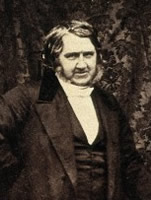Medical pioneer Simpson in spotlight
This year marks the bicentenary of James Young Simpson, one of the University's most distinguished alumni.

Professor Sir James Young Simpson, a medical innovator, studied at the University and went on to become Professor of Midwifery.
He is best known for discovering the anaesthetic properties of chloroform.
Bicentennial events
The University is involved in a number of events to celebrate 200 years since Simpson's birth.
A highlight of the celebrations is a procession of academics, members of the Royal Colleges and the Council to St Giles Cathedral on Sunday, June 5.
The procession will be followed by a service where a wreath will be placed on James Young Simpson's memorial plaque.
Events are being organised by the Royal College of Physicians of Edinburgh, the Royal College of Surgeons of Edinburgh, the Royal College of Obstetricians and Gynaecologists and the Royal College of Anaesthetists.
Looking at the physician's life
A three-day conference - Lad O Pairts: James Young Simpson Bicentennial Symposium - will also take place between June 2 and 5.
It will look at Simpson's gynaecological research, his teaching and his involvement in medical controversies of the time.
The conference is a joint meeting with the History of Anaesthesia Society.
It is supported by the University of Edinburgh Development Trust, the Royal College of Midwives and Nursing Studies at the University.
Simpson’s life is presented not only in terms of his career, but also in relation to his contribution, even manipulation, of the changes that were occurring in both medicine and society.
Simpson and the University
Simpson was born in Bathgate into a family of bakers and started his studies at the University aged 14.
After graduating he subsequently held the post of deputy Professor of Pathology before becoming Professor of Midwifery.
Simpson was the sixth person to hold this chair, which was established in 1726 and is the oldest of its kind in the world.
A plaque commemorating Simpson is located at Teviot Place, on the east wall of the main entrance of the Medical School Building.
A medical discovery
Simpson discovered the anaesthetic properties of chloroform on a November night in 1847.
He awoke to find himself on the floor, while one assistant was unconscious beneath a chair and another was on his back kicking the legs of the table.
Simpson was the first to demonstrate the anaesthetic properties of chloroform in 1847 and immediately introduced it into obstetric and surgical practice in the Royal Infirmary.
The seal of approval was given in 1853 when Queen Victoria took chloroform for the birth of Prince Leopold.
The ability to anaesthetise patients revolutionised surgery in the nineteenth century.
Simpson rapidly gained world-wide fame as the pioneer of anaesthesia, and was one of the dominant figures in the Edinburgh scene for the rest of his life.
All pain is per se and especially in excess, destructive and ultimately fatal in its nature and effects.”
Modern day research
Obstetrics and gynaecology has come a long way since Simpson’s time
Research at the University ranges from studying obesity and its impact during pregnancy to trying to find a test that could easily diagnose ectopic pregnancies.
Clinical trials also range from looking at whether heart drugs known as statins can be used to treat pre-eclampsia to measuring the effectiveness of a male contraceptive jab.
Credits
Image credits:
James Young Simpson: Wellcome Library, London under a Creative Commons by-nc 2.0 license.
Simpson and friends: Wellcome Library, London under a Creative Commons by-nc 2.0 license
James Young Simpson: Wellcome Library, London under a Creative Commons by-nc 2.0 license.
Notice: Wellcome Library, London under a Creative Commons by-nc 2.0 license
Chloroform: Science Museum, London, Wellcome Images under a Creative Commons by-nc-nd 2.0 license

